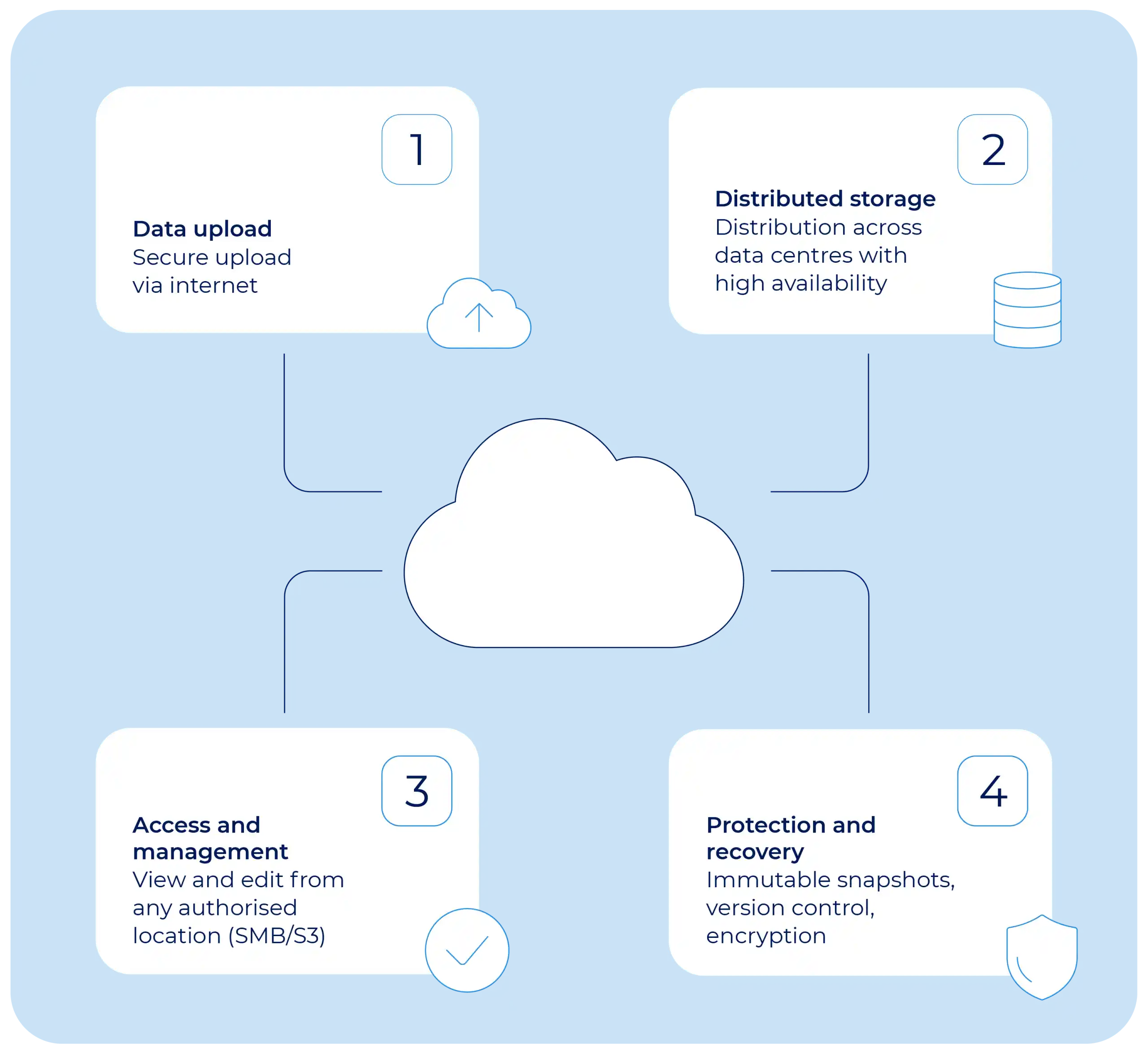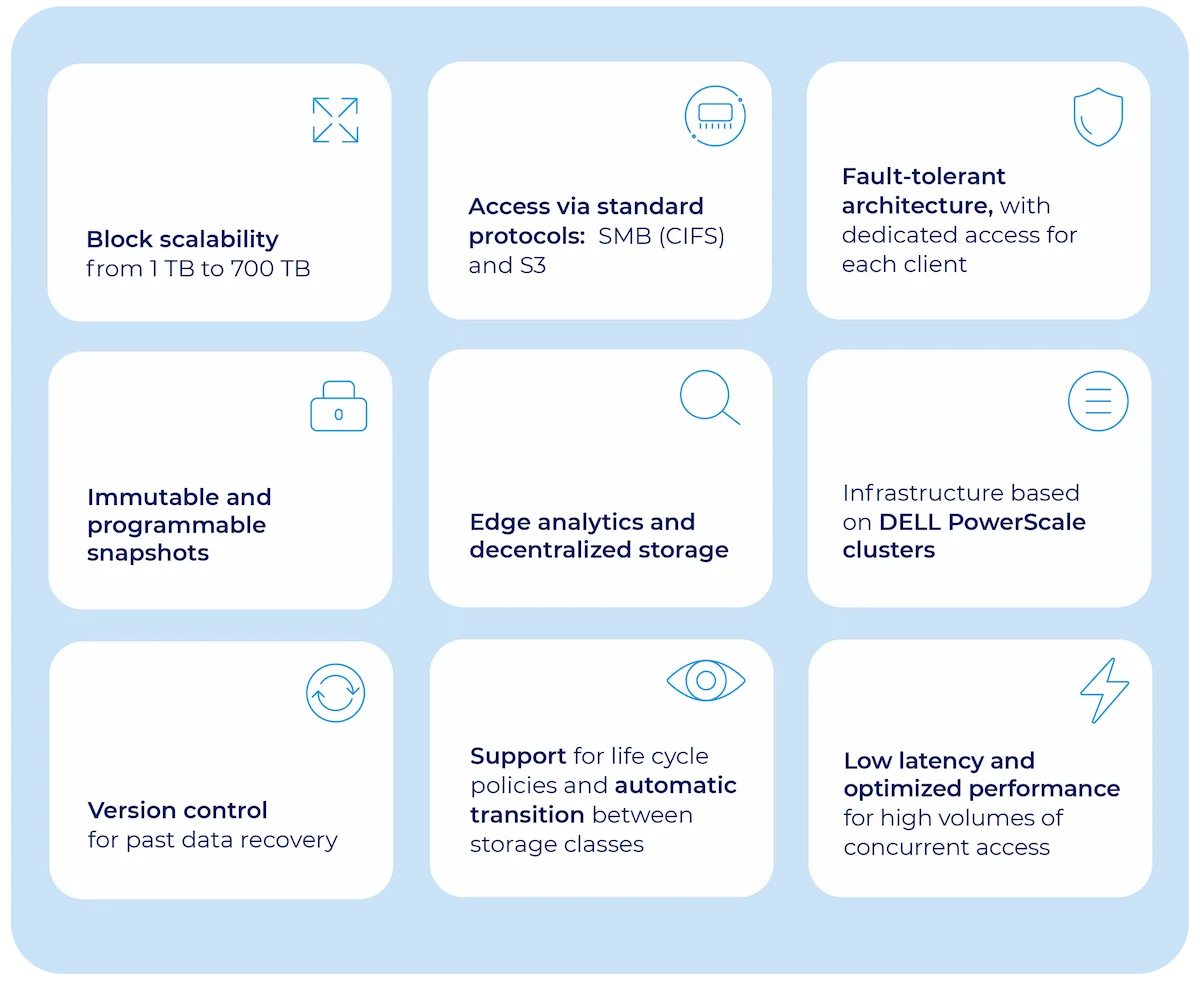The volume of data managed by organisations continues to grow, and with it, the demands for availability, scalability, and protection increase. In this context, cloud storage has become a key component of IT infrastructure, especially in environments where operational continuity and regulatory compliance are a priority.
This article offers a technical and informative overview of what cloud storage is, how it works, and which aspects should be considered when evaluating its adoption in enterprise settings. We also address its role within a broader cloud architecture and its integration into hybrid or distributed infrastructure strategies.
💡 For a more general introduction to what we mean by “the cloud”, you can check out this article.
What is cloud storage?
Cloud storage allows files, systems, and databases to be stored on external servers accessible via the internet. Instead of relying on local hard drives or physical storage arrays, data is hosted in data centres managed by specialised providers. This facilitates remote access, enhances security, and eliminates the need to maintain your own infrastructure.
In short, it’s a more flexible and efficient way to manage information: data is always available, capacity can scale with business needs, and costs associated with local hardware are reduced.
From a technical perspective, cloud storage operates as an independent layer of the client’s infrastructure. It uses standard protocols like SMB or S3, allows automation of retention policies, and offers advanced features such as immutable snapshots, version control, and historical data recovery.
How does cloud storage work?

Cloud storage allows businesses to delegate data management to remote infrastructure without losing control over availability, security, or traceability. Technically, these solutions are based on distributed, scalable architectures designed to grow without compromising performance.
In enterprise environments, cloud storage is typically implemented with logically and physically segmented access per client, ensuring isolation and reinforcing security by design. Many platforms also include edge analytics capabilities, offering visibility into data usage and enabling the implementation of retention, archiving, or deletion policies.
The overall process can be summarised in four stages:
- Data upload
Files, systems, or databases are uploaded to the platform via a secure connection. - Distributed storage
Data is stored on virtual servers in data centres, designed to ensure high availability and fault tolerance. - Access and management
Data can be consulted, modified, or integrated with other applications using standard protocols (like SMB or S3), from any authorised location. - Protection and recovery
Platforms typically include encryption, version control, immutable snapshots, and automated backups to ensure data integrity and recoverability.
Advantages of cloud storage
In an environment where availability and data growth are critical, cloud storage functions as a strategic component of IT infrastructure. Its purpose is not only to store information, but to integrate with workflows, distributed systems, and data protection processes.
A well-designed cloud storage solution enables interoperability with compute platforms, supports secure collaborative environments, and meets regulatory requirements in terms of traceability, encryption, and access control.
Key benefits include:
- Secure storage: protects data against hardware failures, human error, or physical incidents.
- Remote access: allows data to be accessed and modified from multiple devices, without relying on a local network.
- Real-time collaboration: enables simultaneous work on documents and systems, with synchronisation and version control.
- Backup: serves as a recovery environment with quick restore options in case of loss or attack.
- On-demand scalability: adapts to data growth without the need for hardware investment.
In addition, many solutions offer lifecycle automation, tiered access levels, and advanced security measures. This makes cloud storage ideal for environments that demand continuous availability and regulatory compliance.
Technical considerations before adopting cloud storage
Cloud storage offers clear operational advantages, but it also requires thorough technical assessment before deployment, particularly in environments where data is critical or regulated.
Key aspects to consider include:
- Connectivity and availability
Data access depends on a stable and secure connection. Network redundancy, failover recovery time, and the location of service nodes should be evaluated. - Operational cost model
Unlike on-prem infrastructure, cloud storage follows a pay-as-you-go model. Proper sizing is essential to avoid overspending and to maximise cost efficiency per GB stored. - Latency and access performance
Performance varies depending on the provider’s architecture, physical proximity of the data centre, and backend technology (horizontal scaling, caching, etc.). - Regulatory compliance and data sovereignty
Providers must allow control over the physical location of data, offer encryption at rest and in transit, and provide documented guarantees regarding traceability, access, and deletion.
When these factors are carefully evaluated, cloud storage can be integrated as a robust layer aligned with the technical, legal, and operational requirements of the business.
What are the best cloud storage options?

As we’ve seen, cloud storage has become a foundational component of enterprise digital infrastructure. As capacity, availability, and compliance demands grow, it’s increasingly important to rely on solutions purpose-built for business environments.
Adam’s Storage Cloud is designed with this in mind. It’s a secure, scalable storage service hosted in Adam’s own data centres in Barcelona and Madrid. This infrastructure ensures that all data remains on European soil, with low latency and full GDPR compliance.
The service offers access via standard protocols (SMB, S3), includes immutable snapshots, automated data lifecycle management, and is backed by certifications such as ISO 27001, ENS, and PCI DSS. It also includes 24/7 specialised technical support and tailored deployment—without closed automated processes or external platform dependencies. These features are part of an evolving IaaS platform focused on performance and security.
If you want to learn more about how this service is designed and implemented in practice, we invite you to watch Emilio Moreno, Systems Coordinator at Adam, explain the technical approach behind Storage Cloud and how it integrates into enterprise environments with critical requirements.
You can also visit our service page to download the technical datasheet, where you’ll find detailed information on capabilities, supported protocols, security levels, and integration options:

This article has been written by
Adam